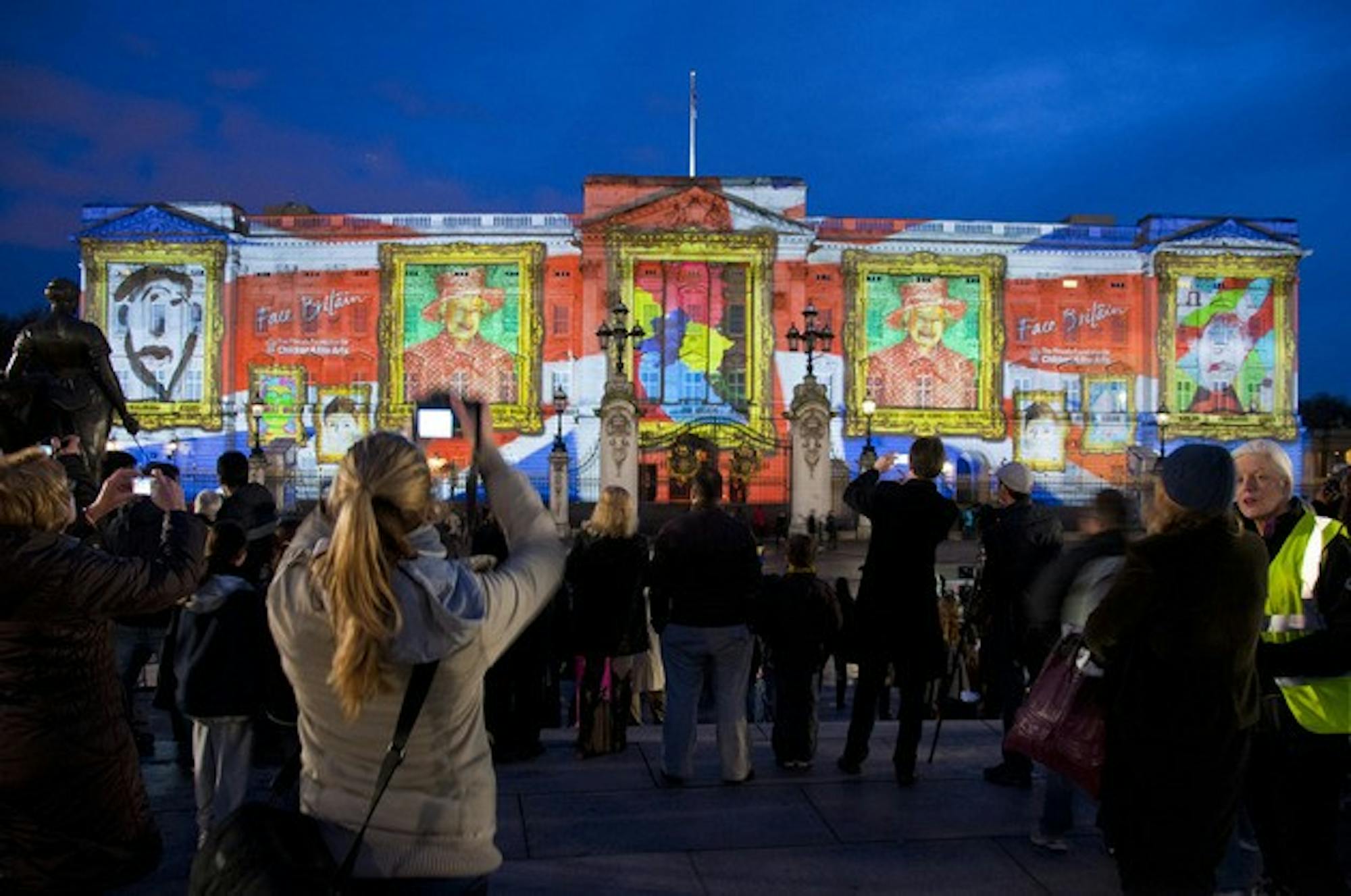Ashton returned to campus this week for the first since the initial commission five months ago, and he said he eagerly anticipates the audience's reaction to his dynamic and colorful manipulation of the Hopkins Center exterior.
"A lot of pieces [of the projection] are talking about the history and the impact a building has on the environment," Ashton said. "It's about a sense of space and place. I always hope that people will see the building in a new way, and I hope to reintroduce the architecture in a new way. The intent is to bring back the history and impact the building had at the time it was made."
This reverence for history and tradition inspired the concept behind Ashton's "Five Windows." In the foreground of the image to be projected, five men wearing overcoats and fedoras gather in what appears to be a demolition site. Behind them are images of dilapidated clapboard houses whose fates seem threatened by the Caterpillar compactor inscribed with Latin words. Ashton layers transparent, neutral images atop one another, a technique reminiscent of a scrapbook and one that evokes nostalgia for times passed. The accompanying music will reinforce the nostalgic tone and further incorporate the viewer into Ashton's carefully constructed multimedia environment. Although Ashton's projection is not a film, it does retain a narrative quality, and the auditory component complements this narrative while heightening the viewer's emotional engagement.
He said he hopes that his projection will rejuvenate the Dartmouth community's appreciation of the Hopkins Center and the artistic innovation it has fostered in its 50-year history.
Despite the novelty of his chosen medium, Ashton likens himself to artists that work with more traditional materials. Like all artists, Ashton said he has learned to operate within the unique restrictions of his medium in his case, projection art. Similar to a landscape painter whose art is dictated by the natural environment and his interpretation of what he sees, Ashton works with the aesthetics of existing structures to offer a coherent and unified image.
"The architecture completely dictates how the images are going to work and how the images interact with the architecture," Ashton said. "The technical problem with the Hop is that it's a big sheet of glass."
Ashton said that he typically prefers solid surfaces to glass ones, but he has developed tactics to accommodate projections onto glass. For "Five Windows," he has installed opaque white sheets on which to project his art.
Initially trained as a photographer, Ashton now works exclusively with projection art. While he does take on smaller projects, most commissions are intended to celebrate specific institutions. Through his projections, Ashton has developed a keen appreciation for architecture as an art form, he said. For Ashton, architecture blends aesthetics with functionality and is emblematic of the culture in which it exists.
"One of the things I love about what I do is that I get the opportunity to learn about different peoples, their culture and environment," Ashton said. Ashton's work also incorporates an auditory component, another distinct property of the medium, he said.
"People never seem to think about sound until it's not there," Ashton said. "For viewers, the sound is secondary, but without it you lose 75 percent of the impact. Because of the animation and the dynamism, this form of creation really does cry out for music."
Ashton's art creates a novel experience for viewers, demanding the involvement of multiple senses in order to fully appreciate the artwork. Viewers first tend to gravitate toward the source of sound and projections, while they then subsequently mill about and explore various perspectives offered through the piece. Ashton said that small children often run through his projections when they see them, casting shadows on the facade and adding a sense of spontaneity and dynamism to the display.
In April, Ashton worked with the Prince's Foundation for Children and the Arts to craft a charity piece corresponding to the Diamond Jubilee celebrations of the United Kingdom's Queen Elizabeth II. Over 200,000 children submitted hand-drawn self-portraits, which Ashton then used as individual pixels in a portrait of the queen. This image was then projected on the facade of London's Buckingham Palace, which marked a world record for the largest number of artists collaborating on one piece.
"It was constantly animated the cells were always changing," Ashton said. "It was my intention that every portrait submitted would be in this piece. It was very important that every child felt that he contributed to a world record. I know if I were a kid, I'd feel very excited and uplifted to know my piece was projected onto Buckingham Palace and part of a world record."
Franny Sadler, a student at Royal Holloway University of London, was able to see Ashton's display at Buckingham Palace when the display was being projected in the spring.
"It was a really cool take on something quite traditional," she said. "The queen is quite old but still really in touch with current affairs, trends and popular culture. The display was a good representation of her, as well, combining the tradition of portraits with new ideas in technology and art."
These innovations eradicate interpretations of the queen as an antiquated figure, instead promoting an image of her as an active, relevant leader, according to Sadler,
The Dartmouth community is invited to gather on the Green at 8:30 p.m. on Friday for refreshments just before the unveiling of Ashton's work at 9 p.m. The projection will continue to be on display until next Tuesday.
After his time in Hanover, Ashton will travel to the Venetian Hotel in Las Vegas, where his first permanent projection in the United States will be installed.




